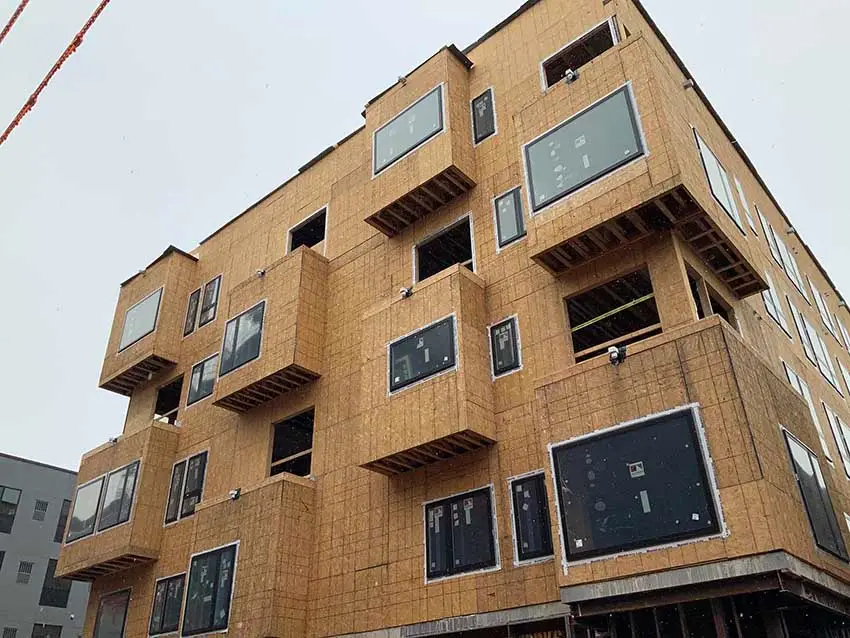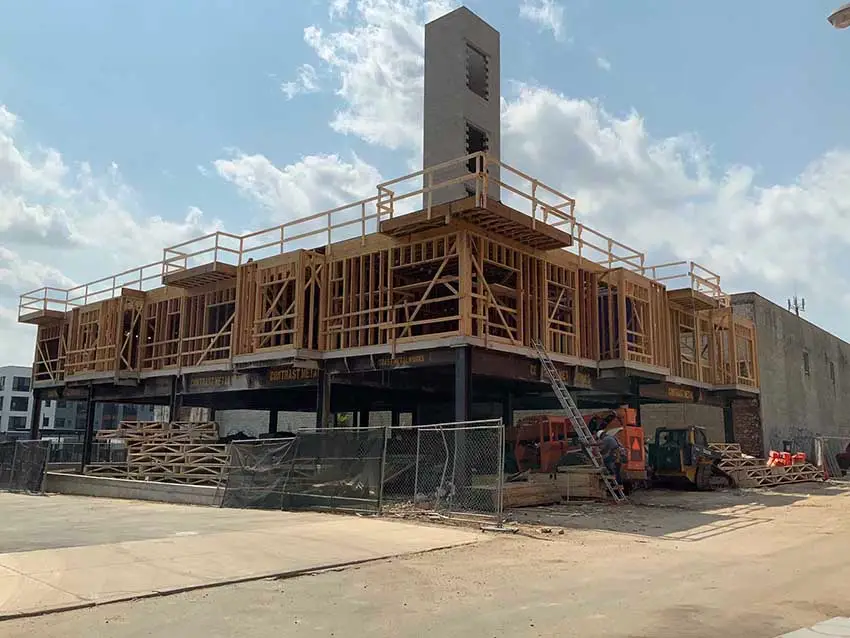BRÜBOX by CosciaMoos Architecture
Philadelphia, PA | Multi-Residential | Tester Construction Group
- Interview Featuring:
- Sergio Coscia
- and
- Alex Nowak

This Brewerytown building by Philly-based CosciaMoos is noteworthy for its oversized openings and bold bays.
BRÜBOX is a new five-story, 30,000-square-foot multi-family building in Philadelphia’s Brewerytown neighborhood. The client wanted a contemporary design that would stand out among the area’s many converted brick breweries. CosciaMoos delivered by leaning into the square site and box-shaped buildable area, maximizing the building’s square footage with protruding bays —“boxes”— that extend the living and bedroom spaces in its 32 units. The boxes, accentuated from the main volume by contrasting cladding, give BRÜBOX its distinctive, almost checkerboard appearance while creating outdoor balconies for enjoying views of the eclectic, rapidly growing neighborhood.
Acelab spoke with CosciaMoos principal Sergio Coscia and project manager Alex Nowak about the building’s large windows and finding creative solutions on a budget.

Brübox’s projecting bays frame views of Brewerytown’s historic brick breweries. (© Image by Jack Zigon)
Acelab: So how did the windows support your design goals or reinforce some aspect of the design?
Sergio: Well, we wanted to make the windows as big as possible to get as much light in as we could. They kind of throw the scale off of the building in a nice way. They’re not scaled like double-hung windows. They’re bigger. They're more prominent. We also wanted window units that have the same squarish shape as the plan to further that theme of the “box”.
Alex: The windows are also used to articulate the volumes and frame views out to the surrounding neighborhood — particularly the historic brewery structure across the street.
Products from this Case Study on Acelab
Windows by: Andersen Windows, Inc.
Click on Images to see more
Browse AllAcelab: There's a flatness to the building envelope. The windows are almost flush with the exterior finish. Was that intentional?
Sergio: There’s a simplicity to it that we wanted, and that I think is appropriate here. If you're going to make these bays prominent and make them a noteworthy feature, then you need to simplify everything else to make that idea come to life.

A fixed window in a second-floor bay that creates a covered entry. (© Image by Jack Zigon)
Acelab: What are the two materials used to clad the bays and the main body of the building?
Alex: They're both James Hardie products. The darker gray is just their panel product, broken up to create a modular grid. And then the siding.
Sergio: We like that, actually, using the siding in this application where it's not a whole building facade. It’s their most affordable product and, you know, it was actually created to look like residential siding. But when you use it in this way, in a more sort of localized manner, it has an abstract quality that we like with the horizontality and the shadow line.
Acelab: Did the windows have to be detailed differently for the bay?
Alex: The details were pretty similar. Our original idea was to have a rain screen behind the panel, but that was VE’d out.
CAD Drawing
Acelab: Can you tell me about the storefront you used?
Alex: It’s just a Rebco aluminum storefront. Thermally broken outside glazed with an insulated panel trim.
Acelab: Were there any special factors you had to consider with it?
Sergio: Not really. Not here. We used tempered glass so if it shatters, it'll just shatter into pieces. Safety glass is obviously more expensive and really only needed in certain conditions.


Acelab: What made you decide to go with Andersen for the windows?
Sergio: A couple things. Cost is always a factor. But we also wanted to stick with the same manufacturer for the sliding patio doors and the windows. And we wanted to use the largest windows and doors we could find. We looked at a few manufacturers, but Anderson was the way to go.
Alex: Yeah. We had to make some of the inward openings smaller than what we originally intended, but the Andersen 100 series still allowed pretty large openings and a variability in mulled units that helped us achieve the fragmented modular aesthetic we wanted.
Acelab: When you're first thinking about specifying windows for a project, where do you start? Are you drawing on past experience? Are you working with a spec writer or spending time researching?
Sergio: Like a lot of firms, over the years we’ve developed standard details and standard requirements. It’s about finding the right size and configuration. And cost and availability. So you weigh all those factors every time.

The windows, slightly projecting here, will be almost flush with the siding when finished. (© Image by Coscia Moos)
Acelab: Any other challenges or noteworthy details that we haven't touched on?
Alex: The entire window system isn’t operable. There are fixed panes and operable units that we had to make sure were sized correctly to meet minimum ventilation requirements for habitable spaces. The other thing is the concealed fasteners. They’re painted or color-matched so you can't really see them at some distance.
Sergio: Some of the challenges related to how the framing works — how you step onto a deck that’s the top of a bay, and how the door fits into that. We also tried to line up the horizontal joint lines with the window tops. That's just about getting the windows to fit within the module and visiting the site frequently to check on the progress.
Thanks to Sergio, Alex, and the CosciaMoos team for their time! You can read more about BRÜBOX on their website.
This interview was conducted by ADvsCOPY for Acelab. It has been condensed and lightly edited.

